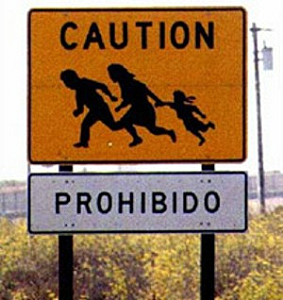John Hood, a Navajo and Vietnam vet, has created many works in his job as a Caltrans graphic artist. But the picture of an immigrant family running has resonated far beyond his office cubicle.
In 1990, the image would be projected onto black vinyl, traced with a knife blade, glued onto yellow signs, topped with one word--CAUTION--and placed on the shoulders of freeways, mostly along Interstate 5 north of the Mexican border.
The sign served as a warning that drivers could encounter people racing across the interstate--most of them trying to get from Mexico into the United States. It would become one of the most iconic and enduring images associated with the nation's war over illegal immigration. And it would leave John Hood, now 59 years old and preparing to retire, conflicted and ambivalent about his strange legacy.
"My childhood," he said with a smile, "was fulfilled in every dimension."
Hood went to boarding school, but much of his education came at home. His grandmother showed him how to shear their sheep and spin the wool into yarn. His grandfather showed him how to pick medicinal herbs and how to gather bright pollen from the tips of cornstalks to use in traditional ceremonies.
Hood illustrated many pieces of his life, sometimes etching his drawings on the walls of his family's barn.
Then there are those who have adopted the image simply because of its notoriety, including shops that offer T-shirts showing the same family carrying surfboards. In a signature installment of his TV show "Mind of Mencia," comic Carlos Mencia--whose family immigrated to East L.A. from Honduras when he was an infant--filmed a segment based on the sign. "Maybe," Mencia says at one point in the segment, "it's telling them: 'Run across the freeway. Just do it really fast.' "
A photograph of the sign is hanging at the National Museum of American History, part of the Smithsonian Institution in Washington.
"In museums, we are constantly looking for objects that transcend their own history," said Peter Liebhold, chairman of the museum's Division of Work and Industry. "This is, without a doubt, an icon of the current immigration debate. It's taken on meaning that was never intended."


No comments:
Post a Comment